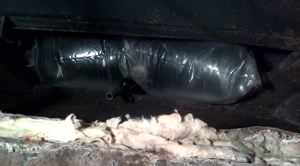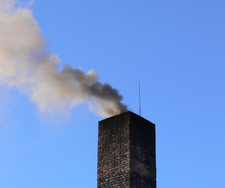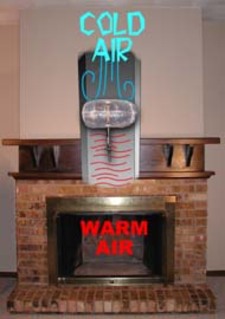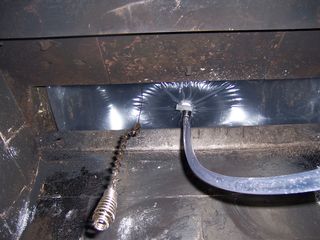
by blogediter | Jul 11, 2018 | Chimney Problems
Q: Jason, When I went to install my 9×15 small Chimney Balloon I got it in there a little sideways. Is it OK the way it is, or should I remove it and install it again? It is sealing tight and no more air is coming through. – EC
A: Dear EC, The Chimney Balloon is in there a little sideways. The handle valve should be coming straight out the Chimney Bottom of the Chimney Balloon through the old damper opening, but if it fills the void and stops the air passage that is the most important thing. It certainly won’t hurt anything to have it in the flue that way you have it. – Jason

by blogediter | Jul 4, 2018 | Chimney Problems
Smokey
Q: Jason – In the winter I like to start a fire in my fireplace to help my furnace heat up my home and save some money. Only I have noticed that my furnace runs almost constantly when the fireplace is going. What is the deal? – CH
A: CH, There is a number of studies and articles on open fireplaces and how they take more than they give. An open fireplace on average runs at about 10% efficiency. This means if your fire produces 1000 BTUs that only 100 are going back into your house. There are some things that you can do to improve that efficiency (here is an article on how to improve the efficiency of a fireplace) but the fact is most of the heat is going to go right up the chimney in an open fireplace. The only reason to burn in an open fireplace is to have the ambiance of the flames. – Jason

by blogediter | Jun 4, 2018 | Chimney Problems
Cicada
Here was a unique problem solved by using a Chimney Balloon. The homeowner below was having an issue with the droning noise of the 17-year cicada locust inside his home. So he used a Chimney Balloon to plug the flue since the damper was disabled due to his gas log fireplace. This reduced the noise infiltration and stopped the creepy cicada bugs from entering his home through the chimney. I have known the Chimney Balloon to work well to stop pigeon noise and other outside noises and critters that come down the chimney, but I never thought of it as a defense against the onslaught of 17-year cicada locust. Here is a quote from Google groups where it was posted:
“These 17-year cicada noises are driving me nuts! Maybe I have sensitive ears. I am trying to soundproof my home as best I can and here are a few steps I have taken. I am open to more options:
1) I keep all the windows shut obviously and run the AC.
2) I noticed much of the noise was coming from my fireplace since I have a gas log and the damper had to be clipped open (via building
code). So I stuffed the chimney with a Chimney Balloon and that all but stopped it. My glass doors did not fdo the trick on keeping the noise out and I even had a few of the little creepers come down the chimney before I put the chimney balloon plug in.
3) I draw the curtains. Maybe this is psychological but it seems to
help a little
4) The little creepers were in my basement window wells as well so i got covers for those.
5) I have been wearing my Bose headphones around with the noise-canceling turned on but no music playing but they are uncomfortable after about 6 hours. ” – GJ
To Read the rest of this thread click here: http://groups.google.com/group/alt.home.repair/browse_thread/thread/fcb86bd2bb5b6fa8/f4abe3adf5871fb9?hl=en#f4abe3adf5871fb9

by blogediter | Jun 1, 2018 | Chimney Problems
OLYMPUS DIGITAL CAMERA
This is a story from a Chimney Balloon customer that talked about their Chimney Balloon and how it solved their leaky & stinky chimney problem on Google Home Improvement groups.
Below was the resolution to their problem:
Hello, I just thought I’d post an update and the conclusion of my fireplace saga, in case it’s of use to the next person looking for fireplace help.
First, we called the fireplace guys back, who said the old damper maybe wasn’t working after all and also found more suicidal squirrels. They removed them and installed a new damper cage.
There was no improvement with the draft, only it was more smoke and less foul. We were considering our options and we’re going to call and give the chimney guys hell.
We decided to get one of those chimney pillows as a temporary stopgap until we could get the problem solved once and for all. In the meantime, we noticed that bricks on both shoulders of the fireplace were loose and there was lots of cracked mortar and moss. There was no direct evidence that this was causing the draft – no air coming out, the lining was intact under the bricks, that we could see at any rate. But it was clear that this was only going to get worse if water and plant life kept getting in and we didn’t want bricks to start falling off the chimney.
So hubby bought a chimney pillow and some sort of masonry cement caulk
and glued the loose bricks and filled in the large cracks.
Instant cure. We weren’t even trying to fix the draft problem, and I still don’t know exactly where the leak was coming from, but this fixed it. We still get some smell when the heat or certain fans are on, but that’s expected. The Chimney Balloon will fix probably that.
MK
This was the initial posting of their fireplace problem:
Hi
Good morning,
I am having an ongoing fireplace saga that I am hoping the good folks here can help me with. We just bought a townhouse this fall, built in 1973, with a fireplace. To make a long story short, here’s the timeline of what’s been going on.
The fireplace was sealed (opening covered in plastic wrap) when we bought the house. We unsealed it. Fire burns fine, but the smoke smell and strong draft pour in when not in use.
Did some research, found out about negative pressure – the house seals like Tupperware so this makes a lot of sense for us. We opened a window in the basement next to the furnace. No change.
Brought in a professional to do the sweep/inspection that we should have done in the first place. He cleans out the chimney, fixes the damper that was apparently never closing, removes an interred squirrel of great antiquity. He also replaces the crown and says water has been leaking in and causing mold for a long time.
The draft problem is now completely fixed, but the strong smell still fills the living room and creeps around the house from there – a foul, wet, moldy-sooty smell.
So I see two angles here. One is trying to improve the condition that is still causing the fireplace air to come in. The other is dealing with the nasty smell in the fireplace. But this is so far out of my realm of experience, I am not sure. I don’t mind a little soot smell, I understand that’s part of owning a fireplace, but you can’t stay in that room and breathe without opening a window.
What should we do? Will a steady regiment of fires and ventilation improve things over time? Is there something more drastic we will need to do? Is there something that might kill the mold we suspect is up there? We think the fireplace may have been sealed from the inside but exposed and leaking to the outside for the 12 years the previous owners lived here. Is there an air-tight plastic cover or something we could fit over it when not in use?
Any help would greatly be appreciated.- MK

by blogediter | Apr 18, 2018 | Chimney Problems
Bird nest material
Q: Jason, Every year during February and March I get birds nesting in my fireplace followed by a swarm of flies getting beyond the closed grate and into the house. Would a Chimney Balloon work keep the flies out or how do I stop the birds from nesting in the fireplace? I would appreciate any suggestions that would help.- LR
A: Dear LR, Birds nests are pretty disgusting places when it comes to bacteria and bird po-po, but this is a springtime wonderland for flies!
So the flies hang out and lay eggs in the bird’s nest material. Then the fly eggs turn into the larva which turns into flies, and they follow the warmth and smells from the chimney down into your home. Voila! you get a swarm of flies down your flue into the house.
Putting in a Chimney Balloon will keep the flies out of your house since you will be effectively sealing their route of entry. As you have already found the metal damper will not keep flies out since dampers do not air seal and flies and maggots can get right through.
Now to stop the birds… You will need a chimney cap with screening on it to keep the birds from entering the chimney top or nesting on the crown. You don’t need anything fancy just a simple cap with a screen on it will do. If you already have a cap, you may be able to fashion a metal cage around it with thick wire mesh to keep the birds out.
Stopping the birds from nesting is important because their nesting material can collect moisture and be detrimental to your chimney interior and it is just nasty bacteria laden stuff. – Jason

by blogediter | Apr 16, 2018 | Chimney Problems
Install Chimney Balloon
Q: I have several questions. My experience with inflatable devices is that they leak. Can one insert the Chimney Balloon and leave it in for months, or does it gradually leak air?
Can one use the Chimney Balloon in a fireplace that one uses almost daily? For example, inflate the Chimney Balloon in the morning and then remove it in the evening when one wants to build a fire? If this is done, does the Chimney Balloon get “messy” covered with soot etc? We have the fireplace cleaned yearly but use it a lot.What is the life expectancy of a Chimney Balloon if it is inserted and not removed for months (a fireplace that we don’t use) vs. one where we would remove it quite often. I wonder if the Chimney Balloon is to be used only in a fireplace that is not used often. Thanks!- DR
A: Dear DR, If you use a fireplace daily you are going to find a Chimney Balloon to be a hassle, if you use it occasionally you will find it a keen energy saver. Since you use your fireplace daily I would recommend that you use your Chimney Balloon seasonally. So put it in when you are done using the fireplace for the season.
If you put a Chimney Balloon in and leave it, it will stay in good shape for 10-12 years. I would suggest once or twice a year you can top off the air, but other than that it is a long-term fixture if you leave it be. The fact of the matter is, if you are constantly inserting and removing your Chimney Balloon sooner or later you will wear it out. The more you move it around the more you wear on it.
The best example I can give is my own. I have a Chimney Balloon in my fireplace and I use my fireplace 6 times per year on average. My Chimney Balloon is going on 5 years now with no issues. I hope this answers your question. – Jason





